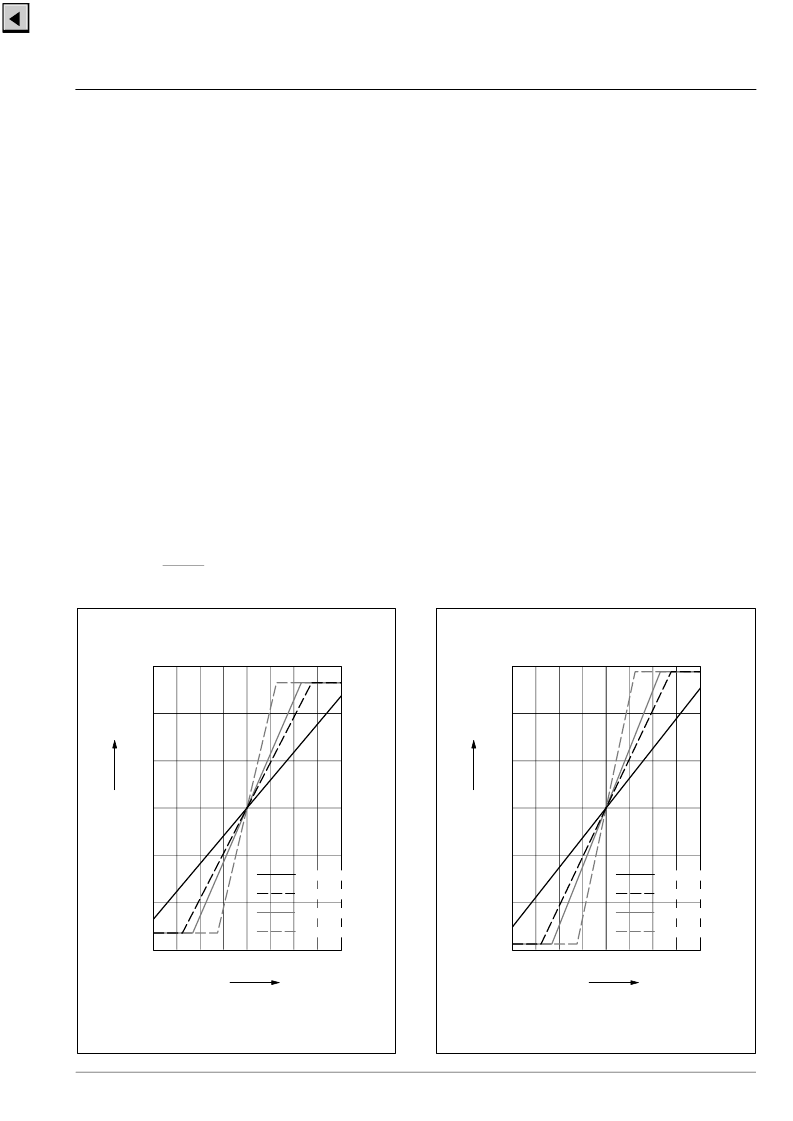- 您現(xiàn)在的位置:買賣IC網(wǎng) > PDF目錄370425 > HAL800UT-A (MICRONAS SEMICONDUCTOR HOLDING AG) Programmable Linear Hall Effect Sensor PDF資料下載
參數(shù)資料
| 型號(hào): | HAL800UT-A |
| 廠商: | MICRONAS SEMICONDUCTOR HOLDING AG |
| 英文描述: | Programmable Linear Hall Effect Sensor |
| 中文描述: | 可編程線性霍爾效應(yīng)傳感器 |
| 文件頁數(shù): | 7/24頁 |
| 文件大小: | 347K |
| 代理商: | HAL800UT-A |

HAL800
Micronas
7
2.2. Digital Signal Processing and EEPROM
The DSP is the major part of this sensor and performs
the signal conditioning. The parameters for the DSP
are stored in the EEPROM registers. The details are
shown in
Fig. 2
–
3
.
Terminology:
SENSITIVITY:name of the register or register value
Sensitivity:
name of the parameter
The EEPROM registers consist of three groups:
Group 1 contains the registers for the adaption of the
sensor to the magnetic system:
MODE for selecting the magnetic field range and filter
frequency, TC and TCSQ for temperature characteris-
tics of the magnetic sensitivity.
Group 2 contains the registers for defining the output
characteristics: SENSITIVITY, VOQ, CLAMP-LOW,
and CLAMP-HIGH. The output characteristic of the
sensor is defined by these 4 parameters (see
Fig. 2
–
4
and
Fig. 2
–
5
for examples).
–
The parameter V
OQ
(Output Quiescent Voltage) cor-
responds to the output voltage at B = 0 mT.
–
The parameter Sensitivity is defined as:
V
OUT
B
–
The output voltage can be calculated as:
The output voltage range can be clamped by setting
the registers CLAMP-LOW and CLAMP-HIGH in order
to enable failure detection (such as short-circuits to
V
DD
or GND).
Group 3 contains the Micronas registers and LOCK for
the locking of all registers. The Micronas registers are
programmed and locked during production and are
read-only for the customer. These registers are used
for oscillator frequency trimming, A/D converter offset
compensation, and several other special settings.
The ADC converts positive or negative Hall voltages
(operates with magnetic north and south poles at the
branded side of the package) in a digital value. This
signal is filtered in the Digital Filter and is readable in
the ADC-READOUT register as long as the LOCK bit
is not set.
Note:
The ADC-READOUT values and the resolution
of the system depends on the filter frequency. Positive
values accord to a magnetic north pole on the branded
side of the package.
Fig. 2
–
6
and
Fig. 2
–
7
show typi-
cal ADC-READOUT values for the different magnetic
field ranges and filter frequencies.
–
6000
–
4000
–
2000
0
2000
4000
6000
–
200
–
150
–
100
–
50
0
50 100 150 200mT
B
ADC-
READOUT
Filter = 500 Hz
Range 150 mT
Range 90 mT
Range 75 mT
Range 30 mT
Fig. 2
–
6:
Typical ADC-READOUT
versus magnetic field for filter = 500 Hz
Sensitivity =
V
OUT
~
Sensitivity
×
B + V
OQ
–
1500
–
1000
–
500
0
500
1000
1500
–
200
–
150
–
100
–
50
0
50 100 150 200mT
B
ADC-
READOUT
Range 150 mT
Range 90 mT
Range 75 mT
Range 30 mT
Filter = 2 kHz
Fig. 2
–
7:
Typical ADC-READOUT
versus magnetic field for filter = 2 kHz
相關(guān)PDF資料 |
PDF描述 |
|---|---|
| HAL800UT-C | Programmable Linear Hall Effect Sensor |
| HAL800UT-E | Programmable Linear Hall Effect Sensor |
| HAL800UT-K | Programmable Linear Hall Effect Sensor |
| HAL805 | Programmable Linear Hall Effect Sensor |
| HAL805UT-A | Programmable Linear Hall Effect Sensor |
相關(guān)代理商/技術(shù)參數(shù) |
參數(shù)描述 |
|---|---|
| HAL800UT-C | 制造商:MICRONAS 制造商全稱:MICRONAS 功能描述:Programmable Linear Hall Effect Sensor |
| HAL800UT-E | 制造商:MICRONAS 制造商全稱:MICRONAS 功能描述:Programmable Linear Hall Effect Sensor |
| HAL800UT-K | 制造商:MICRONAS 制造商全稱:MICRONAS 功能描述:Programmable Linear Hall Effect Sensor |
| HAL805 | 制造商:MICRONAS 制造商全稱:MICRONAS 功能描述:Programmable Linear Hall Effect Sensor |
| HAL805-1 | 制造商:MICRONAS 制造商全稱:MICRONAS 功能描述:Programmable Linear Hall-Effect Sensor |
發(fā)布緊急采購,3分鐘左右您將得到回復(fù)。